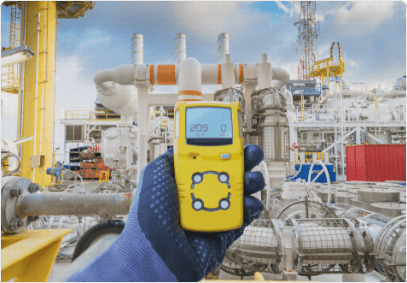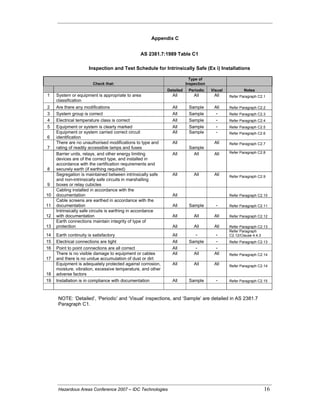All about Roar Solutions
Wiki Article
The Basic Principles Of Roar Solutions
Table of Contents6 Easy Facts About Roar Solutions ExplainedThe 6-Second Trick For Roar SolutionsSome Ideas on Roar Solutions You Should Know
In order to safeguard installations from a possible explosion a method of evaluating and categorizing a potentially harmful location is needed. The objective of this is to guarantee the appropriate choice and installment of devices to ultimately prevent a surge and to guarantee safety of life.
(https://www.giantbomb.com/profile/roarsolutions/)
No equipment ought to be set up where the surface temperature level of the equipment is more than the ignition temperature of the offered hazard. Below are some common dust harmful and their minimal ignition temperature level. Coal Dirt 380C 225C Polythene 420C (thaws) Methyl Cellulose 420C 320C Starch 460C 435C Flour 490C 340C Sugar 490C 460C Grain Dust 510C 300C Phenolic Material 530C > 450C Aluminium 590C > 450C PVC 700C > 450C Residue 810C 570C The chance of the hazard existing in a focus high adequate to trigger an ignition will differ from place to place.
Unsafe location electric devices perhaps made for usage in higher ambient temperatures. Field Repair Work By Authorised Personnel: Complex testing may not be needed nonetheless details treatments may need to be followed in order for the tools to preserve its third party rating. Each item of devices with a harmful rating need to be reviewed individually.
The Best Strategy To Use For Roar Solutions
The tools register is a thorough database of tools documents that includes a minimum collection of fields to recognize each thing's location, technological criteria, Ex category, age, and environmental information. This details is crucial for tracking and taking care of the tools effectively within harmful areas. In contrast, for routine or RBI sampling examinations, the grade will be a mix of In-depth and Close inspections. The proportion of In-depth to Shut evaluations will certainly be identified by the Devices Risk, which is assessed based on ignition danger (the probability of a resource of ignition versus the probability of a flammable ambience )and the dangerous location category( Zone 0, 1, or 2). This variant will certainly additionally influence the resourcing needs for job preparation. When Whole lots are defined, you can establish tasting strategies based on the sample size of each Whole lot, which refers to the number of random devices things to be checked. To determine the required sample dimension, 2 facets require to be assessed: the size of the Great deal and the group of examination, which shows the degree of effort that ought to be applied( reduced, normal, or enhanced )to the assessment of the Great deal. By incorporating the category of inspection with the Lot size, you can then establish the ideal being rejected standards for an example, indicating the allowed variety of damaged things located within that example. For even more details on this process, please refer to the Energy Institute Standards. The IEC 60079 common suggests that the maximum interval between evaluations ought to not go beyond 3 years. EEHA evaluations will additionally be performed beyond RBI campaigns as part of scheduled upkeep and devices overhauls or Get More Info fixings. These examinations can be attributed toward the RBI sample dimensions within the influenced Great deals. EEHA evaluations are conducted to determine mistakes in electric devices. A weighted racking up system is vital, as a solitary tool might have multiple mistakes, each with varying levels of ignition threat. If the consolidated score of both inspections is much less than twice the fault rating, the Lot is regarded appropriate. If the Lot is still taken into consideration inappropriate, it should undergo a complete inspection or validation, which might trigger stricter evaluation methods. Accepted Great deal: The root causes of any type of mistakes are identified. If an usual failure setting is found, extra devices might require maintenance. Mistakes are identified by intensity( Security, Stability, Home cleaning ), making certain that urgent problems are examined and addressed immediately to minimize any kind of effect on safety and security or operations. The EEHA database must track and record the lifecycle of faults along with the rehabilitative activities taken. Implementing a durable Risk-Based Inspection( RBI )technique is critical for ensuring conformity and safety in handling Electrical Tools in Hazardous Areas( EEHA) (eeha). Automated Mistake Rating and Lifecycle Administration: Effortlessly handle faults and track their lifecycle to boost inspection precision. The intro of this assistance for risk-based examination even more enhances Inspectivity's setting as a best-in-class option for governing conformity, along with for any kind of asset-centric inspection usage case. If you want discovering more, we welcome you to ask for a demonstration and discover just how our remedy can transform your EEHA monitoring procedures.
An Unbiased View of Roar Solutions

In terms of eruptive danger, a dangerous area is a setting in which an eruptive ambience exists (or might be anticipated to be existing) in quantities that call for unique preventative measures for the building, installation and usage of equipment. eeha courses. In this short article we explore the challenges encountered in the workplace, the risk control actions, and the needed competencies to function safely
It issues of modern-day life that we manufacture, save or manage a range of gases or liquids that are regarded flammable, and a variety of dusts that are regarded combustible. These materials can, in certain problems, develop eruptive atmospheres and these can have significant and tragic repercussions. A lot of us are familiar with the fire triangle get rid of any type of one of the 3 elements and the fire can not happen, yet what does this mean in the context of dangerous locations? When damaging this down into its most basic terms it is essentially: a combination of a particular amount of launch or leakage of a certain material or material, blending with ambient oxygen, and the existence of a resource of ignition.
In the majority of instances, we can do little about the levels of oxygen airborne, yet we can have significant influence on sources of ignition, for instance electric tools. Hazardous areas are recorded on the harmful location category illustration and are recognized on-site by the triangular "EX-SPOUSE" indicator. Here, among various other essential info, zones are split into 3 types depending upon the danger, the possibility and duration that an explosive atmosphere will exist; Zone 0 or 20 is deemed one of the most dangerous and Zone 2 or 22 is considered the least.
Report this wiki page